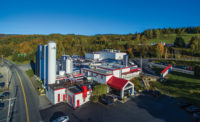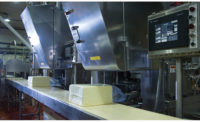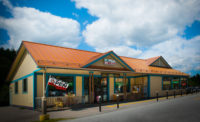Can cheesemakers save the world? If any can, it might be Vermont-based Cabot Creamery Cooperative, the processing arm of Agri-Mark, the Northeast dairy cooperative.
Cabot says it is the world’s first cheesemaker and dairy cooperative to achieve B Corporation certification. B Corps are judged on their social and environmental performance, accountability and transparency, as certified by the nonprofit B Lab.
Cabot rates highly on all criteria. The award-winning maker of cheese, butter and cultured dairy products encourages volunteering in the community, and rewards individuals and groups with free cheese and yogurt. The co-op’s manufacturing plants have reduced their consumption of natural resources, converted to energy-efficient equipment and recycle packaging materials. (See related article) Dairy farmers (there are 1,200 members) convert manure into energy and bedding for cows.
Agri-Mark, based in Andover, Mass., ranked No. 46 on the 2015 Dairy 100, this magazine’s listing of the largest dairy processors in North America. Cabot is based in Waitsfield, Vt. Total sales in 2014 were $1 billion, with finished product sales of $650 million. Agri-Mark markets more than 3.5 billion pounds of milk annually, ranking the firm 14th on Hoard’s Dairyman’s 2015 list of the largest cooperatives.
Making cheese and yogurt requires a lot of milk. The rule of thumb is 10 pounds of milk to make 1 pound of cheese and roughly 1 pound of milk to make 1 pound of Greek yogurt. It might seem that dairy cooperatives with a processing arm have it a bit easier because they own the milk source. When demand for dairy products is high, co-ops like Agri-Mark don’t have to scramble for milk like other dairy processors do.
But it’s not that simple, explained Agri-Mark CEO Ed Townley, who met with Dairy Foods in the co-op’s office in Waitsfield, Vt.
A tanker every 8 minutes
“I’ll start with the challenges,” Townley said. “I don’t know how much product I’m going to get, and I don’t know how much I’m going to get day to day, let alone month to month, or year to year. So we have to have facilities that can handle everything that they can make. Plus, we have to have the ability, if we can’t handle it, to find a place that we can actually sell excess into, if there is any excess.”
Agri-Mark operates four manufacturing plants that make cheese, cultured dairy products, butter, nonfat powder and whey powders. The cooperative has 1,200 dairy farmers in New England and New York. The dairy cows on these farms produce 3.1 billion pounds of milk a year. That volume contributes to the complexities of dairy farming and dairy processing.
“We have a tanker load of milk being delivered every 8 minutes, 24 hours a day, 7 days a week and 365 days a year,” Townley said. “You’ve got a traffic department that is controlling a huge amount of trucks going in every which direction, which site needs them, who can handle it, who’s got extra space at the moment. Gee, the schools are out, so we’re going to need to make more powder this week. It’s got to go to West Springfield instead of going to a bottler, and things like that.”
Townley was promoted to CEO in May 2015, succeeding 33-year veteran Richard Stammer who became the senior VP of special projects. Townley has been at the cooperative for more than a decade, most recently serving as chief financial officer and then chief operating officer. The transition had been in the works for two years.
All the office staff and the manufacturing employees know that the business is “all about the farmers,” Townley said. “And it’s amazing, as you go through the company, how many people understand that we’re here to make profits for the farmers. One hundred percent of the money that we make goes back to the farmers.”
Agri-Mark’s plants in Cabot and Middlebury, Vt., and in Chauteaugay, N.Y., make cheese, yogurt and dairy powders. The plant in West Springfield, Mass., churns cream into butter, and manufactures condensed products and nonfat dry milk powders. Milk not used by Cabot is sold to bottlers, including HP Hood, Guida’s (a unit of Dairy Farmers of America) and Garelick’s (Dean Foods).
The co-op’s customers include retailers, foodservice businesses and overseas food businesses. Exports account for about 7% of the cooperative’s revenues. Agri-Mark received the 2013 Tom Camerlo Exporter of the Year award from Dairy Foods, in conjunction with the U.S. Dairy Export Council (see November 2013 issue).
Customers and products
Agri-Mark’s retail customers include the big box stores, national and regional grocery chains, and independent specialty stores. Panera, the upscale quick-service restaurant, uses Cabot’s Cheddar cheese in sandwiches. Food manufacturers at home and abroad use whey powders in their prepared foods.
Walmart and its Sam’s Club stores have given Cabot cheeses nationwide distribution. Other big box customers are Costco and BJ’s Wholesale Club. But Cabot and McCadam are primarily East Coast brands available from Maine to Florida at grocery chains, including Hannaford’s and Food Lion (both owned by Delhaize America), Giant and Stop & Shop (Ahold), Publix and Harris Teeter (now owned by Kroger).
The cheeses are sold in the dairy case and in the deli department in various formats. Cabot offers bars, chunks, slices, snack-sized “cracker cuts” and shreds. Deli loaves are packaged in vacuum-sealed packages or wrapped in parchment. These cheeses are aged about two months longer than the dairy case cheeses.
The company is looking to expand to the Midwest. That’s where national brands Kraft (in Illinois) and Sargento (in Wisconsin) are based. It’s also where consumers are used to seeing orange Cheddar, not the white, which is the norm in New England. (Cabot makes orange Cheddar for Walmart.)
Publix gave Agri-Mark a boost in the Greek yogurt business years ago. The Florida-based chain was an early adopter of the category, carrying Cabot’s 10% fat Greek yogurt packaged in two-pound tubs. The co-op’s marketing people could not figure out why a high-fat dairy product was doing so well. After investigating, it found out shoppers were using the yogurt as a sour cream substitute.
As Greek yogurt sales increased, Publix took on Cabot’s 2% plain and vanilla products. Cabot tried a one-pound package but abandoned it because the marketplace was too crowded with offerings from other yogurt companies. That’s also the reason the co-op has no plans to make single-serve yogurts.
Cheesemakers are unique among dairy processors in that a byproduct can be turned into a revenue stream. Bottling milk or churning ice cream does not produce whey but cheesemaking does. The watery ingredient used to be flushed down the drain or spread on farmers’ fields. Then cheesemakers realized they could dry it and sell it.
Townley called Agri-Mark’s decision in 1999 to build a $17 million evaporator a “hold your gut that we’re going to be okay” moment. At the time, the co-op was only making $3 or $4 million a year, he said. Today, about 7% of Agri-Mark’s revenues come from sales of whey to customers in the United States and in 30 other countries.
The dairy industry’s promotion of protein helps all processors, especially cheesemakers. Whey protein powders are used to boost protein in various processed foods. It fortifies yogurts and is used in exercise recovery beverages. Cabot developed its own whey protein powder for consumers last fall, but was not marketing it effectively, Townley said. Since then, it found a broker who will help Cabot relaunch the product this year.
Agri-Mark’s research scientists are developing other uses for whey. One project is to create an egg substitute that bakers can use in breads and pastries. The whey has a high protein value and low fat content yet offers the consistency of an egg.
The cheese marketplace
Retail sales of Cheddar cheese ($3.9 billion in 2014) far outstrip those of its nearest competitors (cheese product at $1.7 billion and cream cheese at $1.5 billion), according to data from IRI and reported in Dairy Facts, published by the International Dairy Foods Association. Yet per capita consumption of Cheddar was 9.68 pounds in 2014, about a third of a pound less than in 2010, according to the USDA. Production has increased slightly to 3.263 billion pounds in 2014 from 3.235 billion pounds in 2010, and the number of plants making Cheddar has increased to 218 from 197 in the same period.
Unlike fresh cheeses, Cheddar has to age before it is sold. Cabot waits at least six months before releasing product for sale; its bread-and-butter product is aged about a year. The sharper the cheese, the longer it has been aged. In a sense, the cheese represents money sitting on a shelf. But CFO Matt Hendricks said it is worth the wait.
“We have really attractive branded cheese margins and a growing, thriving business,” Hendricks said. “We happen to be one of the only companies in America that is doing this (naturally aging cheese). Our competitors use enzymes to accelerate the aging and they don’t quite get the flavor profile that we get from a natural aging process. It’s costly, but it puts that premium into our quality.”
New flavors and formats
Food companies are always developing variations on a theme, and Cabot is no different. Cabot has experimented with, and sold, a vast number of flavored cheeses over the years. These are all developed in-house by employees working in a lab with a small vat in the cheese plant in Cabot, Vt. Cheesemaking requires a long lead time, but Townley said the R&D group has sped up the process.
“They’ve gotten to the point where they can wait three months,” he said. “They can see whether or not [the cheese has] the consistency or the flavor that they want. Then they’ll re-tool again. So every three months they could be making it, as opposed to waiting a full year for the aging process to take place.”
Spicy flavors are in vogue, including cheeses made with chipotle and habanero peppers. A new line is called the Farmers’ Legacy Collection. These are four “European-inspired” Cheddars with their own distinct flavor profiles. Cabot also markets Cheddars in a range of sharpness, from sharp to extra sharp to “seriously sharp.” The latter is said to be the Cheddar “that bites back.” There is also a clothbound cheese that is aged in the caves of Vermont cheesemaker Jasper Hill.
A new format is the cracker cut. These are small slices packed in reclosable tubs. The convenience of opening up a tub and taking out a single portion appeals to a lot of consumers.
Perhaps it’s their thrifty New England nature that has the cheesemaker looking for a new use for a product rather than throwing it away. Trimmed cheese that is created after packaging bars and loaves is packaged into 25-pound bags and sold to food processors. Cabot’s food scientists also are developing an American cheese that is made from the trim.
About 40% of Cabot’s business is in the private label field. It stays out of the commodity business. The aim is to make profitable value-added products with members’ milk.
Marketing taste and quality
In marketing the Cabot brand, the company promotes its farmer roots, milk quality and product taste.
“We pay a lot of extra money to our farmers for quality,” Townley said. “We have somatic cell counts on the farm that are, on average, about 200,000,” he said, compared to U.S. and European limits of 400,000 or less.
Brand Communications Manager Nate Formalarie said the Cabot brand is “about making quality cheese with quality milk and supporting the 1,200 families that make up the co-op. That’s really what we try to make sure people know about.”
With no large budget for consumer advertising, the co-op relies on social media channels like Facebook, Instagram and Twitter and its own blog to educate consumers about naturally aged cheeses. It also courts independent food bloggers.
“We’ve had good success with Facebook,” Formalarie said. “We do a daily ‘moo.’”
These are pictures of cows with captions (in the voice of the cow) like, “My farmer has me out in the pasture today” or “My mom says new babies are exhausting and she needs to sit down for a bit.”
Jimmy Kennedy is Cabot’s chef who develops recipes using the dairy’s cheese, butter, yogurt and sour cream. He’s also the go-to resource for local television programs that need a chef to demonstrate a new dish. Cabot participates with other Vermont-based food companies, for example, collaborating with King Arthur Flour on baking recipes that use Cabot butter.
What seals the deal for Cabot is tasting the products. So the marketing department works industry trade shows like IDDBA and takes cheese and yogurt directly to consumers. It looks at the farmers for inspiration.
“We view how our farmer owners interact with their local communities,” Formalarie said. “They’re often volunteering. We try to take that spirit to our fans and consumers with things like our Gratitude Grille (see photo on page 58). We also have a volunteer rewards program.”
Expansion and growth plans
The Agri-Mark cooperative was formed in 1913, beginning as the New England Milk Producers Association. Cabot’s history dates to 1919 when 94 farmers formed a co-op. They paid $5 per cow plus a cord of wood to fuel the boiler. The Cabot co-op sold milk and butter, and in the 1930s, it started making cheese.
In 1980, Agri-Mark bought the HP Hood Co., and restructured the relationship in 1990, transferring all the dairy plants to Hood. Agri-Mark and Cabot merged in 1992. In 2003, the Chateaugay Cooperative merged with Agri-Mark and Agri-Mark bought the assets of McCadam’s cheese from Valio of Finland. During the tenure of former CEO Stammer, Agri-Mark invested over $100 million in plants and operating equipment. It bought the Middlebury plant from Kraft Foods and converted it from Swiss cheese to Cheddar cheese production.
The limits to growth are many, but Townley sees the opportunities. There is limited land suitable for dairy farming in New England. That’s why the merger with the Chateaugay co-op in New York was so important. It brought in more milk supply. Agri-Mark has closed membership to new farmers for the time being. But there is a concern about losing members or milk volume. Some older farmers downsize their herds in order to reduce their workload. Other family farmers don’t have children interested in taking over the business.
To grow sales, the company has to look outside of New England and the East Coast. It is expanding distribution of its cheeses west of the Alleghenies. And Walmart has made Cabot available nationwide.
Another factor that can limit growth for any dairy brand is the finite amount of refrigerated space in a grocery. Unless retailers add more space, they have to eliminate products or categories to make room for new products. Cabot is looking outside of the traditional dairy case for placement. It makes canisters of shelf-stable Cheddar cheese powder (see page 75) that can be used in macaroni and cheese recipes or shaken on popcorn.
“We’ve been able to very successfully grow the Cabot brand 3% to 4% a year,” Townley said. “When you’re looking at the limited amount of manufacturing that we have, we’re converting over private label and putting it out as a branded product. I believe that we’ll continue to expand nationally.”
World demand for whey protein products by U.S. and international customers is another area of growth. A strong dollar and weak demand from China are hurting all dairy exporters at the moment. But Agri-Mark is committed to the dairy ingredient business.
Perhaps the strongest evidence in Agri-Mark’s belief that it will thrive in the future is the renovation and expansion of its New York cheese plant where it is replacing four existing cheese vats. New construction will add four more. When completed, the plant will double the cheesemaking capacity and call for another 400 million pounds of milk.
Can Agri-Mark save the world? We’ll have to wait and see. But the co-op will keep family-owned dairy farmers busy for a long time to come.
Photos by Vito Palmisano








